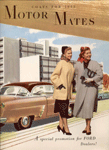
Gender and the Automobile in American Life and Society
Women drivers have come a long way since the early decades of the twentieth century, when many people contended that women could not, or should not, drive a car at all. But if we now take the sight of a woman behind the wheel for granted, we tend nonetheless to be surprised when women display interest and ability in areas still thought to be “masculine.” Thus when Danica Patrick finished the 2005 Indianapolis 500 in fourth place, the highest finish ever for a woman, it landed her rather than the race’s winner on the cover of Sports Illustrated.
In her overview essay, Margaret Walsh traces the history of women as drivers, purchasers, and builders of automobiles. She discusses the impact of the car on women’s lives over the course of the twentieth century, from the farm wife suddenly able to drive to town in her Model T, to the suburban housewife of the post-World War II decades, to the working “soccer mom” of today who balances commuting to work with chauffeuring the kids. Virginia Scharff then focuses more closely on the story of femininity and the electric car in the early twentieth century. Scharff shows that at the same time the electric car was becoming seen as a “woman’s” car (even Henry Ford bought his wife an electric), automakers were incorporating many of its “feminine” safety and comfort features into the supposedly “masculine” gasoline-powered car.
Gender and the Automobile in the United States
Femininity and the Electric Car
About the Project | Credits | Contact Us | Student & Teacher Resources | Site Map
©2004-2010 Automobile in American Life and Society
